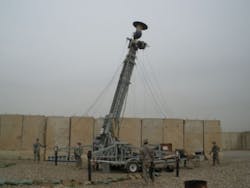Army surveys industry for reconnaissance and targeting sensors for relocatable surveillance towers
Companies interested should provide the Army with information on technologies, capabilities, and qualifications to satisfy the Army's need for RSTA capability for the Cerberus surveillance tower. Response should discuss the company's technologies that meet these criteria, any related performance test results, and any past performance in related projects.
The Army's Cerberus surveillance sensor tower typically uses perimeter ground radar to detect and track potential attackers; unattended ground sensors for coverage in radar skip zones or in heavy foliage the radar cannot penetrate; and video motion detection with staring cameras that can be independently positioned to fill gaps in radar or cover avenues of approach.
Motion-detection software offers an alarm to any motion in the system's field of view and presents an image and a track of the target. The Cerberus camera suite switches to infrared at night. Powering Cerberus is a small generator with battery backup. Cerberus sensors use a two-way wireless link for commands and data flow. Several towers can be networked together to extend perimeter coverage. Cerberus will offer solutions for force protection needs, and for civil homeland security for border, port, and infrastructure security.
Companies interested should with five-page papers written in Microsoft Word. E-mail responses no later than 4 April 2011 to The Army's Kevin Nguyen at [email protected]. Phone Nguyen at 703-704-4559 for questions or concerns.
More information is online at https://www.fbo.gov/notices/ffbb12a209ae45d9526d8e20cca4434a.
